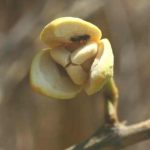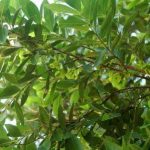TREE LIFE
AUGUST 1980
MASHONALAND CALENDAR
Saturday 2nd August : Botanic Garden Walk. Meet in the car park at 1045 hours.
Sunday 17th August : A visit to Mr. M. Townsnd’s Lowdale Farm on the upper Mazoe. No bus this month. Meet to share transport at Reps Car Park at 0900 hours or Ashbritle Service Station at 0915 hours.
Saturday 23rd August : Learner Group. Mr Gill Masterson has kindly offered to have a learner session on this day. Those attending meet at Mrs. Masterson’s house. Please phone her, to book, and to confirm meeting time, on 303435.
Tuesday 2nd September : We revert to the summer Botanic Garden walk, meet in the carp park at 1645 hours.
LAKE MCILWAINE ARBORETUM ; Saturday 5th July
Members were impressed by the growth of trees in the cleared area, and generally happy about the state of the arboretum.
The line Ficus soldanella on top of the Sentinel Hill has not grown much, it is less than a metre high, but the root has expanded rapidly. The planted Khaya nyasica has grown well but does not seem to have flowered or fruited yet.
It would be of interest to compile a list of which introduced indigenous and exotic species have thrived, survived or demised, for there has been little attention or watering to them in recent years, due to security problems.
Credit must go to those who put so much time and effort into the arboretum in the early days of the Society.
VISIT TO DARWENDALE DAM : 20TH July, 1980
After a miserably cloudy and arctic Saturday, Sunday dawned bright and sunny – a brisk and perfect day during which we happily explored the banks of the Hunyani River and clambered up and down the adjacent hillside, below the Darwendale Dam.
Trevor Gordon was our leader for the day, and he it was who enlightened us on the geology, rainfall and botanical characteristics of the area, planned and guided our wanderings.
As an aperitif however, he had arranged for us to see the inner workings of the triple sluice gate system within the Dam Wall, and to have a demonstration of one of the gates fully opened. It was an interesting insight into the technical ingenuity harnessed to ensure that the water release mechanism is actuated at, and by pre-determined water levels; and the torrent from the gate which was opened for a short while for our benefit, was a spectacular climax to the demonstration. All members present will feel themselves contributors to the letter of appreciation sent by our Chairman to Mr. Caldicott, the Hydrological Engineer for this most friendly and informative interlude. On Trevor’s part it was just something in keeping with his long record of arranging for every meeting he leads, to have something novel for us, or some extra stimulus to the day’s enjoyment.
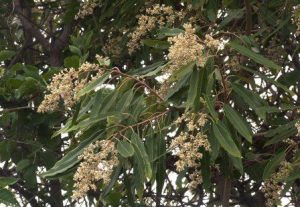
Ozoroa longepetiolata. Photo: Bart. Source: Flora of Zimbabwe
The Darwendale Dam opened in 1977, has a capacity of 490 million cubic metres, a maximum depth of 22.6 m, and a surface area of 8 100ha. The water banks up almost to Lake McIlwaine, and we could see Hunyani Poort (through which McIlwaine spills), from the Darwendale Dam Wall. The latter is on the Great Dyke, and an immediate reminder of the relationship was the attractive stand of Aloe ortholopha planted in the vicinity. Ozoroa longipetiolata, another Dyke endemic, occurs naturally in the vicinity. We learnt from Trevor that rainfall is higher further North, and the vegetation therefore of greater range and density, except in heavily mineralised sectors. Nevertheless we found our area of exploration on the pyroxenite very rewarding, and more than 90 species, inclusive of shrubs, were recorded. The altitude at the site was 1 350m say, 4 400’.
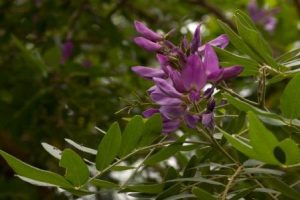
Mundulea sericea. Photo: Bart Wursten. Source: Flora of Zimbabwe
Zimbabwe’s principal plant families, in terms of numbers of species of trees, shrubs and woody climbers, are LEGUMINOSAE, RUBIACEAE and EUPHORBIACEAE, so it is not surprising that members of these families tend to outnumber other species in our expeditions. This was no exception. The mufuti or ‘Prince of Wales feathers’ tree, Brachystegia boehmii, was no exception. The Brachystegia boehmii and B. glaucescens, mountain acacia, clearly found the altitude and broken country to their liking, musasa and munondo did not. There were four species of Acacia, with A. karroo and A. rehmanniana in the majority, a lot of white bauhinia, B. petersiana, and Cassia singueana, in gay yellow flower and copious fruit. Eight other legumes, included Ormocarpum kirkii which we come across fairly infrequently, and the dainty little Mundulea sericea, which, later on, will emphasize its elegance with racemes of purple flowers.
Tarenna neurophylla was probably the foremost of the RUBIACEAE, and yet again some of us were inclined to confuse it with the equally numerous Pleurostylia africana which it resembles superficially, but does not have the inter-petiolar stipules of all “rubiates”. There were seven other members of the Rubiaceae family, including Vangueria and Vangueriopsis.
Among the Euphorbiaceae of which there were seven species, were Pseudolachnostylis maprouneifolia, the duikerberry, or, as it is known south of the Limpopo, the kuduberry, Bridelia cathartica, Margaritaria discoidea, previously known to us as Phyllanthus discoideus, and the “Tassel berry”, Antidesma venosum, which seems to come our way more often at the lower altitudes.
The COMBRETACEAE, another large family group, included Combretum apiculatum, C. hereroense, C. molle, Terminalia mollis, T. sericea and T. stenostachya.
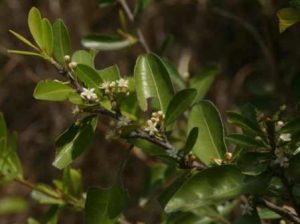
Erythroxylum emarginatum. Photo: Bart Wursten. Source: Flora of Zimbabwe
Some of the smaller families were proportionately very well represented. We have only one genus in the family ERYTHROXYLACEAE, and one of our two species of this genus. Erythroxylum emarginatum greeted us time and again on our walks. Our sole representative of the family PITTOSPORACEAE, Pittosporum viridiflorum was, rather hardheartedly, in fruit. Mr. Gordon ensured that we would not miss the special pleasure of familiarizing ourselves with Olax dissitiflora which we so seldom see on our excursions from Salisbury. Ximenia caffra, sour plum, another member of the small family ANNONACEAE, and was in bud. This tree has a fruit, more or less the shape and size of a monkey nut, which is sometimes called ‘baboon’s breakfast’. Of the same family is Friesodielsia obovata, the refreshing red, elongated fruit of which was enjoyed by members during the recent Umniati visit.
EBENACEAE produced four species of Diospyros and two of Euclea for our edification; we saw the gently drooping leaves of the ‘rubber tree’, Diplorhynchus condylocarpon , family APOCYNACEAE, throughout the day, and the languorous Boscia, Boscia salicifolia, the ‘willow leaved Boscia’, family CAPPARACEAE, favoured the termite mounds in proximity to the river.
On one such mound we puzzled over an unusual creeper with petiolate, cordate leaves and strikingly unusual fruit. The new fruits resembled large flower buds with 5 purple tinged petals about to open; the old ones had opened wide, with the calyx now much paler, and forming a 5 winged base from which emerged an upright, inch long, almost tubular seed base of the same hue. The name, we learnt later from the Herbarium, was Turbina stenosiphon. It is of the Convolvulus family.
With so much to see and such beauty to absorb, conscious study of botanical family affiliations was apt to become submerged in the sheer contentment of the day.
The dark red autumn leaves of Flacourtia indica on the hillside constantly drew the eye, when it was resting on quieter colour tones such as the lovely silvery-pink flower spikes of Faurea saligna. Along the shore line indigenous willows and waterberry trees, Salix subserrata and Syzygium guineense subsp. barotsense, vied with the tapering leafed Nuxia oppositifolia, the slender riverine Rhus quartiniana, the long-petioled Mimusops zeyheri and the shapely wild olive, Olea africana in welcoming the sunshine with fresh green splendour. Massed among them, where nature’s artistry dictated a little contrast, were the tiny, round, dark leaves which fan out in gem like clusters from Diospyros natalensis, the silver and green of the two toned foliage of the fragrant Croton gratissimus in bud, Diospyros mespiliformis, in fruit, rightfully claiming its place near water, and Olax dissitiflora, more mature and richer in leaf cover than its hillside relations.
Displaying its olive green leaf surface, as if a little shy of the sharply contrasting beige of the under surface, the Stem-fruit Bequaertiodendron magalismontanum demonstrated its versatility by appearing both close to, and away from the sparkling, clear, moving water of the river. Like the Bequaertiodendron, we had to tear ourselves away from the river to board the bus for Salisbury.
-Dick Petheram
SOME FURTHER OBSERVATIONS ON RUWA/HALLAM DAM VISIT IN JUNE
On our field trips we often find ourselves discussing lake shore conditions and the effect of a new dam on its immediate environment – such was the case in June when we went to John Danckwertz farm and we postulated that the sandy soil permitted the water table well inland and this was possibly the reason for the excessive height of the legume, Crotalaria pallidicaulis. When we saw this plant in 1968 on the riverine fringe below Hallam Dam wall its maximum height was approximately 2 metres. In June I found one specimen nearly 5 metres high, presumably it had got its roots down into the permanent water table resulting from the lake.
The same factor may be the reason for the very vigorous colonies of Mundulea sericea, another legume with decorative flowers and leaves rather like Bolusanthus. We commonly see M. sericea along river banks but not in such colonies or so far away from the water as by Hallam Dam.
The high water table was also presumably the cause of the vigorous growth of that stout trunked creeper Adenia gummifera.
Another interesting observation, not this time resulting from the water table, but maybe a result of increased air moisture close to the lake was the familiar yellow flowered Kalanchoe species, which is usually seen on cracks in granite outcrops, venturing up into the air and growing as an epiphyte on tree trunks. I would be interested to hear if this species adventure is possible evolution has been observed elsewhere.
-G.HALL
MAKABUSI WOODLANDS
This newsletter will be out too late to serve as a reminder of the MWA open day on 27th July, but it hoped that a good number of members attended.
The woodland is now leased to the MWA who plan to build a conservation education/interpretative centre for the use of Salisbury’s Senior and Junior citizens. The association does not have members on an annual subscription basis, but instead encourages “Friends of the Makabusi Woodlands”. The cost of becoming a ‘friend’ is a single payment of $2 per adult and $1 for scholars and such registration entitles ‘friends’ to a distinctive metal badge. Anyone interested can register at the Wild Life Society Shop in the Monomatapa or write to the Association at P.O. Box 4665, Salisbury.
The MWA has also called on our society for assistance in any aspect of the preservation and development of this valuable area. Members of various sub-committees are needed, as well as advice on the ‘tree aspect’ of the Woodland management. And, of course, donations are always gratefully received.
“ENERGY SYMPOSIUM 1980”
A Symposium entitled “Wood Fuel – The burning Question” has been organised by the Energy Resources Office of the Ministry of Mines and Energy Resources. The Symposium will extend over two days and will be addressed by 7 speakers, who will present various Socio-economic aspects of wood fuel use in Zimbabwe, and details of schemes in operation. Dates are 14th October, when delegates will be taken on a tour of relevant centres of interest and a full day devoted to speakers papers on the 15th October.
There is a registration fee of $15 per person; first come first served. Application forms available as from 1st September.
THE CROW PROBLEM AND TREES : Now that various bylaws have presumably controlled the owners of Salisbury’s notorious barking dogs, public attention has turned to the crows!
Accusations so far levelled at the unfortunate birds include their implication in spread of disease, fouling of buildings, noise pollution and the killing of trees. The spate of public complaints have prompted the Salisbury City Council to consider an extermination programme – a drastic move considering that there is no published research to show that crows spread any more disease amongst humans than do the equally prolific bulbuls and pigeons, or, for that mater the simple interchange of coins or notes between persons.
The tree killing aspect too seems immaterial since it would take a large roosting group several years to kill one tree, and then, probably, a gum tree is involved.
As a result of all the publicity, a student at the University of Zimbabwe is under taking an Honours project to determine the extent and seriousness of all problem aspects of the pied crow. Members are asked to supply any information regarding roosts, nests or feeding sites in and near the city area, which they notice during tree hunting activities.
Does anyone have any comment on “crows killing trees”
Any information, please, write in to our box number or contact me, Cheryl Haxen, at the University of Zimbabwe, Zoology Department, phone 303211 ext. 459.
MSASA ‘BLEEDING’
A few issues ago a reader asked about her ‘bleeding’ musasas, and I am indebted to several readers for their comments, and I will mention in particular Judy and Jack Reid, who have a lovely collection of musasas on their property. Important ones too because their growth has been dated for over 30 years, so Jack can point out which specimen has grown from ground level in that time and is the same size as its neighbour which has seemingly remained the same size in that time.
Apparently the ‘bleeding; is caused by the grubs of the Longicorn beetles. I do not know what a Longicorn is so perhaps the editor can add a footnote to this as I am sure she is very knowledgeable on the subject.
Certainly the ‘bleeding’ can look very realistic, I have known people following a blood spoor to be temporarily side tracked.
-C.HAXEN
FOOTNOTE; In reply to George Hall’s query about Longicorn Beetles, the editor must confess to ignorance on the subject. However, thanks to Dr. Phelps at the Zoology Department for the relevant information :
Longicorn Beetles (Family Cerambycidae) are just one of the species of beetles to infest musasas. They are distinguished by very long antennae, sometimes of greater length than the adult’s body. The adult deposits eggs in the bark of the tree, and the larvae thereafter burrow inwards feeding upon the tissue.
However, another beetle, of Family Buprestidae, is a far more common parasite and is probably responsible for most of the ‘bleeding’ we see. It is a small slightly iridescent beetle with short antennae. Once again, it is the larva which bores into the wood; these being “comma” shaped, with large head and curved body.
Some bleeding is undoubtedly caused by the feeding of these larvae, but the more profuse leak of gum is often the result of a bacterial or viral infection which begins at the entry point of the boring larva. Whether the larva or adult actually carries the infection to the tree via the mouth parts I am not certain, but this is likely.
-C.HAXEN
MATABELELAND BRANCH
Sunday 3rd August : Meet at Hillside Dams (Upper Dam Wall) at 0830 hours, to use the key of Trees of Southern Africa”. Take morning tea.
Sunday 7th September : Meet at 0830 hours at the junction 11th Avenue and Jameson Street, for a visit to Khamera Nature Reserve. If tea is desired, bring pack which can be carried. Lunch available at the Café. Mini talks will be resumed.
Sunday 5th October : Circular Drive Burnside. Meet at 0845 hours at the relay station. Bring refreshment pack.
INDIGENOUS TREES FOR SMALL GARDENS
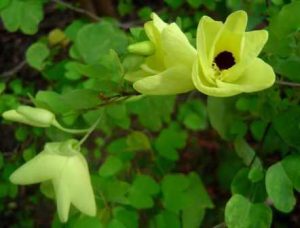
Bauhinia tomentosa. Photo: Bart Wursten. Source: Flora of Zimbabwe
It is a great pity that so many people will remove all indigenous vegetation when first planning a garden in a small area. Unlike plants it takes years for trees to grow to a decent size and although the trees may look stumpy and half dead, it is amazing the change after a year of careful pruning and fertilising. So many trees may not be very beautiful in themselves but they do attract the birds – especially Acacia trees – and also the bees which are needed to pollinate your fruit trees.
- There are many wild trees which are as beautiful as imported ones and which would enhance any garden. Here is a list of twelve trees which could be grown in the garden to great advantage. 1) Wild wisteria, Bolusanthus. This is one of the most beautiful trees I know. Its lovely tassels of pale blue to dark blue flowers appearing in September and October make a gorgeous display. Then comes the sprays of delicate grey green leaves graceful hanging from the drooping branches, a very worthwhile garden tree which is easily obtainable from any nursery. 2) All Bauhinias are beautiful, but I recommend Bauhinia tomentosa, a small tree or shrub with lovely large yellow flowers, which are to be seen from December to March. 3) Combretum paniculatum or fire bush is covered with a mass of red flowers in early spring, hence its name, it is really a climber or it can be pruned to become a shrub or a small tree. Since it is to be found in lower altitudes it should be planted in frost free areas. 4) The Sabi Star has been successfully grown in many parts of Bulawayo. It should be planted in a frost free area, sheltered from wind and in a raised bed or rockery consisting of a good percentage of sandy soil so as to give it good drainage. I have had flowers on mine lasting from late March till October. 5) Any of the Ochnas would be an unusual attraction in the garden with their vivid coloured fruit and peeling bark and bunches of yellow flowers. If you wish to try any in your garden, consult with National Parks or the Herbarium in Salisbury, as some seeds are very difficult to germinate. 6) Erythrina lysistemon a is a very useful tree in the garden especially if planted near the outside fence, as it can grow fairly large. Its clusters of brilliant red flowers in spring, before the leaves appear, stand out vividly against the sky, and the sunbirds love them. If it is pruned carefully it can make a good shade tree for shade loving flowers to grow beneath. 7) If you are lucky enough to have a rocky outcrop in your garden, plant a Ficus near the summit, especially one of those whose roots grow over the rocks and grasp them. Ficus glumosa would be a good tree to have. 8) Although Albizia tanganyicensis is a fairly large tree it can be easily trained to grow tall and would give excellent mottled shade over quite a wide area. The flowers, which are white and like powder puffs, cover the whole tree in spring, the fruit is flat, long, wide and a beautiful golden brown. The effect is very striking. 9) Gardenia spatulifolia has very beautiful and large white flowers which turn yellow with age. The tree tends to bush out rather too low down, so prune off the lower branches to make it a better shape. 10) Brachylaena rotundata is a very beautiful tree covered with pale yellow flowers in spring, and later with white puff ball of fruit. Its leaves are a lovely silvery green and can provide a vivid contrast if grown next to a dark leaved tree. 11) If you want a vivid colour in your garden, plant a musasa tree and watch it change to vivid red in spring. 12) Dais cotinifolia, the pom pom tree has clusters of pale pink flowers in spring, which show up brightly against the dark foliage. 13) It is a great pity that so far no one has managed to germinate successfully seeds of the Wild Violet Tree, Securidaca longipedunculata, the most beautiful of all our small indigenous trees. At the moment I am experimenting with seeds kept dry over a period, then well soaked, and planted into long containers of cardboard, for the wild violet seeding soon dies if the tap root is damaged.
Before planting your wild trees check with the National Parks, Herbarium or the Tree Society or nurseries to get the best information on soil, situation and whether it is a fast growing or slow growing plant.
Before concluding this short article I must mention that these are not the only wild trees which could be planted in your garden. There are many others so before deciding look around especially in the parks and open spaces of your city to find many more.
-J. Davids
GEORGE HALL CHAIRMAN


